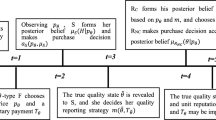Abstract
In this paper, building upon information acquisition theory and using portfolio methods and system equations, we made an empirical investigation into how online vendors and consumers are learning from each other, and how online reviews, prices, and sales interact among each other. First, this study shows that vendors acquire information from both private and public channels to learn the quality of their products to make price adjustment. Second, for the more popular products and newly released products, vendors are more motivated to acquire private information that is more precise than the average precision to adjust their price. Third, we document a full demand-mediation model between rating and price. In other words, there is no direct linkage between price and rating, and the impact of rating on price (the vendor learning) as well as the impact of price on rating (the consumer learning) are all through demand. Our results show that there is no fundamental difference between the pricing decisions with and without the consumer generated contents. The price is still driven by the supply and demand relationship and vendors only adjust their price in response to review change when those reviews impact sales. We proposed either the impact of reviews has been incorporated into sales or reviews are less truth worthy due to potential review manipulation. Given the complicate situation, we call for further study to unveil this double learning process with double blinding results.





Similar content being viewed by others
Notes
In this paper, we use sales rank instead of sales because Amazon does not provide the actual sales number. For sales rank, that information is public available.
This estimation is available through SYSLIN procedure in SAS. Qualitatively, the results do not change when we use 2SLS.
References
Amrouche, N., & Yan, R., (2015). A manufacturer distribution issue: How to manage an online and a traditional retailer. Annals of Operations Research. doi:10.1007/s10479-015-1982-6.
Ancarani, F., & Shankar, V. (2002). Price levels and price dispersion: A comparison of pure play vs. bricks-and-mortar vs. bricks-and-clicks e-tailers. Working Paper, SDA Bocconi, Milan.
Anderson, T. W. (2005). Origins of the limited information maximum likelihood and two-stage least squares estimators. Journal of Econometrics, 127(1), 1–16.
Atiase, R. (1980). Predisclosure informational asymmetries, firm capitalization, financial reports, and security price behavior. Ph.D. dissertation, University of California, Berkeley.
Bailey, J. P. (1998). Electronic commerce: Prices and consumer issues for three products: Books, compact discs, and software, Organization for economic co-operation and development. OCDE/GD, 98, 4.
Baltagi, B. H. (2001). Econometric Analysis of Panel Data (2nd ed.). Chichester: Wiley.
Bergen, M. E., Kauffman, R. J., & Lee, D. (2005). Beyond the hype of frictionless markets: Evidence of heterogeneity in price rigidity on the Internet. Journal of Management Information Systems, 22(2), 57–89.
Boulding, W. (1990). Unobservable effects and business performance: Do fixed effects matter? Marketing Science, 9(1), 88–91.
Brynjolfsson, E., & Smith, M. (2000). Frictionless commerce? A comparison of Internet and conventional firms. Management Science, 46(4), 563–585.
Cortese, A. E., & Stepanek, M. (1998). Good-bye to fixed pricing? How electronic commerce could create the most efficient market of them all. Business Week (May 4), pp. 71–84.
Chevalier, J., & Mayzlin, D. (2006). The effect of Word of mouth on sales: Online book reviews. Journal of Marketing Research, 43(3), 345–354.
Chen, P.-Y., Wu, S.-Y., & Yoon, J. (2004). The impact of online recommendations and consumer feedback on sales. In Proceeding of the international conference on information systems (pp. 711-724). Washington, DC.
Chong, A. Y. L., Li, B., Ngai, E. W., Ch’ng, E., & Lee, F. (2016). Predicting online product sales via online reviews, sentiments, and promotion strategies: A big data architecture and neural network approach. International Journal of Operations & Production Management, 36(4), 358–383.
Dellarocas, C., Awad, N. F., & Zhang, X. (2004). Exploring the value of online reviews to Organizations: Implications for revenue forecasting and planning. In Proceedings of the 25th international conference on information systems (ICIS), Dec 2004. Washington, DC.
Dellarocas, C. (2006). Strategic manipulation of internet opinion forums: Implications for consumers and firms. Management Science, 52(10), 1577–1593.
Erevelles, S., Rolland, E., & Srinivasan, S. (2001). Are prices really lower on the Internet? An analysis of the vitamin industry. Working Paper, AGSM.
Gaikar, D. D., Marakarkandy, B., & Dasgupta, C. (2015). Using Twitter data to predict the performance of Bollywood movies. Industrial Management & Data Systems, 115(9), 1604–1621.
Godes, D., & Mayzlin, D. (2004). Using online conversations to study word of mouth communication. Marketing Science, 23(4), 545–560.
Gu, B., & Ye, Q. (2014). First step in social media: Measuring the influence of online management responses on customer satisfaction. Production and Operations Management, 23, 570–582.
Hu, N., Liu, L., & Zhang, J. J. (2008). Do online reviews affect product sales? The role of reviewer characteristics and temporal effects. Information Technology and Management, 9(3), 201–214.
Jiang, Y., & Zhao, J. (2014). Co-creating business value of information technology. Industrial Management & Data Systems, 114(1), 53–69.
Kim, O., & Verrecchia, R. (1991). Trading volume and price reactions to public announcements. Journal of Accounting Research, 29, 302–21.
Kim, O., & Verrecchia, R. (1994). Market liquidity and volume around earnings announcements. Journal of Accounting and Economics, 17(1), 41–68.
Kim, O., & Verrecchia, R. (1997). Pre-announcement and event-period private information. Journal of Accounting and Economics, 24, 395–419.
Lee, Ho Geun, Lee, Seung Chang, Kim, Hae Young, & Lee, Ran Hui. (2003). Is the internet making retail transactions more efficient? Comparison of online and offline CD retail markets. Electronic Commerce Research and Applications, 2(3), 266–277.
Li, X., & Hitt, L. M. (2008). Self-selection and information role of online product reviews. Information Systems Research, 19(4), 456–474.
Liu, Y., Li, H., Peng, G., Lv, B., & Zhang, C. (2015). Online purchaser segmentation and promotion strategy selection: Evidence from Chinese E-commerce market. Annals of Operations Research, 233(1), 263–279.
Morton, F. S., Zettelmeyer, F., & Risso, J. S. (2001). Internet car retailing. Journal of Industrial Economics, 49(4), 501–519.
Ngai, E. W., Moon, K. L. K., Lam, S. S., Chin, E. S., & Tao, S. S. (2015). Social media models, technologies, and applications: An academic review and case study. Industrial Management & Data Systems, 115(5), 769–802.
Schneible, Jr. R. A., & Stevens, Douglas E. (2005). Pre-announcement and event-period private information: A trading volume analysis of firm size and institutional ownership effects (Sep 30). Available at SSRN: http://ssrn.com/abstract=817565.
Shen, W., Hu, Y. J., & Rees, J. (2015). Competing for attention: An empirical study of online reviewers’ strategic behaviors. MIS Quarterly, 39(3), 683–696.
Sobel, M. E. (1982). Asymptotic confidence intervals for indirect effects in structural equations models. In S. Leinhart (Ed.), Sociological Methodology (pp. 290–312). San Francisco, CA: Jossey-Bass.
Author information
Authors and Affiliations
Corresponding author
Rights and permissions
About this article
Cite this article
Hu, N., Dow, K.E., Chong, A.Y.L. et al. Double learning or double blinding: an investigation of vendor private information acquisition and consumer learning via online reviews. Ann Oper Res 270, 213–234 (2018). https://doi.org/10.1007/s10479-016-2243-z
Published:
Issue Date:
DOI: https://doi.org/10.1007/s10479-016-2243-z




